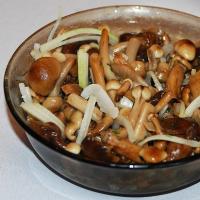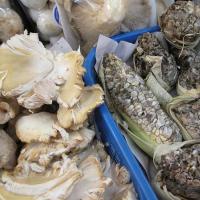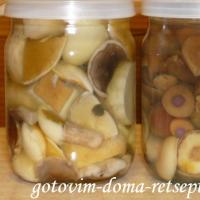What mushrooms appear in spring
The first month of spring - March - is traditionally called the "dead season" in Russian-language literature on mushroom picking, especially published in Russia. But we are located much further south, in Ukraine, and even in March it is quite possible to pick edible mushrooms in the forest here.
Mushroom place in the spring forest
In the first decade of this month, you can count on the capture of such mushrooms as winter honey agaric and oyster oyster mushroom in quite good condition. Oyster mushrooms are most often found on old aspens, poplars, and ash-leaved maple, which is common in our places. And winter mushrooms - more often on ancient willows and willow bushes, but also on the same aspens and maples. However, these are already the last layers of such mushrooms, and they, nevertheless, belong to late autumn and not spring, therefore, in this material dedicated to spring mushrooms, we no longer talk about them.
Also, for the whole month of March, in the forest on old elderberries, and maybe on alders (the main thing is that the tree trunks are not very thick), connoisseurs collect Auricularia ear-shaped, also known as Judas' ear or Black tree fungus Muer. Yes, yes, this is the same muer that is sold in Asian departments of supermarkets at inadequate prices.

Judas ear in spring
Depending on the availability of precipitation in this spring month, the mushroom may be in a wet consistency or dry. But this is not a problem, because within 30 minutes after immersion in driving, Auricularia ear-shaped acquires an absolutely healthy appearance and the right consistency. By and large, this mushroom can be harvested all year round, but it is especially relevant in March, since there are still not so many spring edible mushrooms in this month as in other seasons.
Now let's move on to the actual spring mushrooms. In the forests on the hills in early spring, the fruiting bodies of one of the very first edible spring mushrooms appear - March Hygrofor, or Early Hygrofor (links to the descriptions of the mentioned mushrooms will be at the end of the article).

Hygrophorus early - spring mushroom
They are looking for him, raking the mounds of last year's fallen leaves. This mushroom is not very well known and not very common, and it is more common in the mountains, but there is something to profit from on the plains of Ukraine in the first days of spring.
In the third decade of March, the first specific spring mushrooms already appear - morel caps. The morel cap is the scientific name of a certain spring species, and they must be distinguished from the morels, but in the conversations and reports of mushroom pickers, the morel cap is often called simply the morel. A characteristic feature of the morel cap is the free edge of the cap, in contrast to several morel species, in which the lower edge of the cap is attached to the stem.

Typical spring mushroom - morel cap
Where to look for them in the spring? Most often - in aspens, in damp places in lowlands without grass, covered with last year's aspen litter. Often such mushrooms stick out directly from melted puddles in the forest. But the real season of the morel cap begins in April and lasts no more than 2 weeks.
Another type of cap, found in spring on wet soils, is a conical cap. Like the morel cap, this mushroom has a free cap edge, but, unlike the morel cap, the conical cap has almost no “dents”, there are no plates or pores under the cap, and the shape of the conical cap is also irregular - in in general, it is not at all the same as that of “normal” mushrooms.

The conical cap grows in spring
At the same time, and in the same places, a significant number of bright red sarcoscyphs grow, forming peculiar bouquets on rotten wood, immersed in manured wet soils. This mushroom is edible, although its nutritional value is questionable, their fruiting bodies are very flimsy. But definitely beautiful :-).

Spring mushroom Sarkoscifa cinnabar-red
And what's next? What other spring mushrooms can be picked in the forest in April? At the time when the morel cap leaves, the season of dumb mushrooms - lines - begins in the forest. Stitches (not to be confused with the morel!) are widespread spring mushrooms that grow mainly in pine forests on sandy soil or on the remains of deciduous wood.

Mushrooms Stitches in the forest in spring
They used to be considered excellent edible mushrooms, but now it has been proven that even with the right processing, morels, especially the common morel, can be deadly. To a lesser extent, this applies to the giant morel and the bunch morel, but not every novice mushroom picker can immediately distinguish them, so you need to be extremely careful. The common line has long been deleted from the list of edible mushrooms in Europe, but in Russia it is still considered conditionally edible, since in colder climates it contains much less poison than its European relatives. Yes, and we, in Ukraine, still have enough lovers of this dangerous mushroom, in the spring of Kyiv they are even sold at the ruins near the metro and in other crowded places.
But why not switch at this time to picking the harmless conical morel - an edible mushroom with a beautiful appearance and delicate taste?

Morel conical grows in clearings on light sandy soils in pine forests interspersed with aspens, birch and young alder. You need to look for it in the clearings, edges. And if you find the right place with the first conical morel discovered, then with a high probability you will get at least a couple of dozen more of these mushrooms there, they grow in bunches.
And here is the end of April, and there are the May holidays. At this time, it is customary for us to move out into nature, to the banks of the Dnieper or the Desna, burn fires, fry kebabs. And in such places, under willow bushes, near fires, at this time we collect, as it seems to me, the most delicious of morels - the common morel. If the morel season is successful, then it can be found in orchards, and even on lawns.

And in shady places on manured soils, look for the May Ryadovka. Its second name, St. George's mushroom, is due to the fact that this mushroom appears in the spring on the day of St. George. When processing the May row, when washing, you can feel that your hands become, as it were, “soapy” - this is his feature. The smell of the mushroom resembles the common morel. In some countries, the mushroom is considered a delicacy, in our country it is “an amateur”.

May row
Another spring edible mushroom, which grows abundantly in May, has the same ambiguous taste properties - sulfur-yellow polypore. Large bright yellow bunches of tinder fungus on the trees can be seen from afar.

Polypore sulfur-yellow - May
Its taste is either adored or violently rejected :-). This mushroom is also called forest or tree chicken - yes, there is something similar to chicken breast in the structure of the mushroom, and even when frying, a chicken-like smell sometimes breaks through. But only if these are young fruiting bodies, the consistency of a ripe avocado. Old tinder fungi are not good for food. Most likely to find this mushroom in the spring on old willows near the water, on some acacias in ravines, and other deciduous trees. Less often - on conifers, but this option is not tasty - it is noticeably more bitter.
There is another edible mushroom in spring, with a more unambiguous mushroom taste - scaly polypore. He is also good, only while young and hopelessly useless in old age - very tough. For several seasons, it bears fruit on the stumps of linden, maple, and other deciduous trees, until it turns them into dust.

Well, since we are talking about edible spring tinder fungi, it is worth, even as a curiosity, to mention such options as winter tinder fungus and tiger tinder fungus. Both are suitable for food only at the youngest age, which happens to them precisely in the spring.

The tiger tinder fungus is found on wet wood near swamps, forming a kind of spring mushroom bouquets. Tinder fungus winter - in ordinary forests, also on dead branches. Both mushrooms are small, quickly acquire a rigid texture, so there is no need to seriously talk about nutritional properties.
On rotten wood, deer fungus (deer whip) also appears in spring, not that it is already very tasty, but quite edible.

More delicious spring mushroom - Entoloma garden. In May, it grows in large groups in orchards, most often under apricots, apple trees and other stone fruits. He even received a popular name appropriate - podbrikosovik.

But closer to the second half of May, fun days come for most of the mushroom pickers, who prefer classic edible mushrooms to any little-known exotic. In young pine forests, most often in clearings and forest edges open to the sun, already in May (strictly speaking, in warm years - even in April!) Oils appear, this is the so-called first layer of oil. In mixed young pine-birch self-seeds, beautiful mushrooms - boletus mushrooms - come out in spring. And in deciduous forests, already in May, the first layer of well-known and valued porcini mushrooms grows.

Whoever is lucky can harvest the first crop of champignons in the spring (the main thing is not to confuse them with spring fly agaric). In the spring, they form their first fruiting bodies and dung beetles. Varieties of dung beetles, such as homemade or shimmering, are of dubious nutritional value, and are poisonous when combined with alcohol. But the white dung beetle is a true delicacy, but strictly until the plates under the cap begin to darken.

At the same time of the year, in spring, in the forests you can also find all sorts of saucers, melanoleuks, tremors, psatirrella, etc. etc., but this is more interesting for mycologists, and not for ordinary mushroom pickers. By the way, mushrooms that appear in spring can be divided into two groups: some form their fruiting bodies exclusively at this time of the year (morels, stitches, sarcoscyphs, May rowing), others are found in forests and meadows for a long time, until autumn (boletus, boletus , White mushrooms). And sulfur-yellow and scaly tinder fungi will form after May, take a vacation and form the second layer around August.
Join our new group lovers of silent hunting



